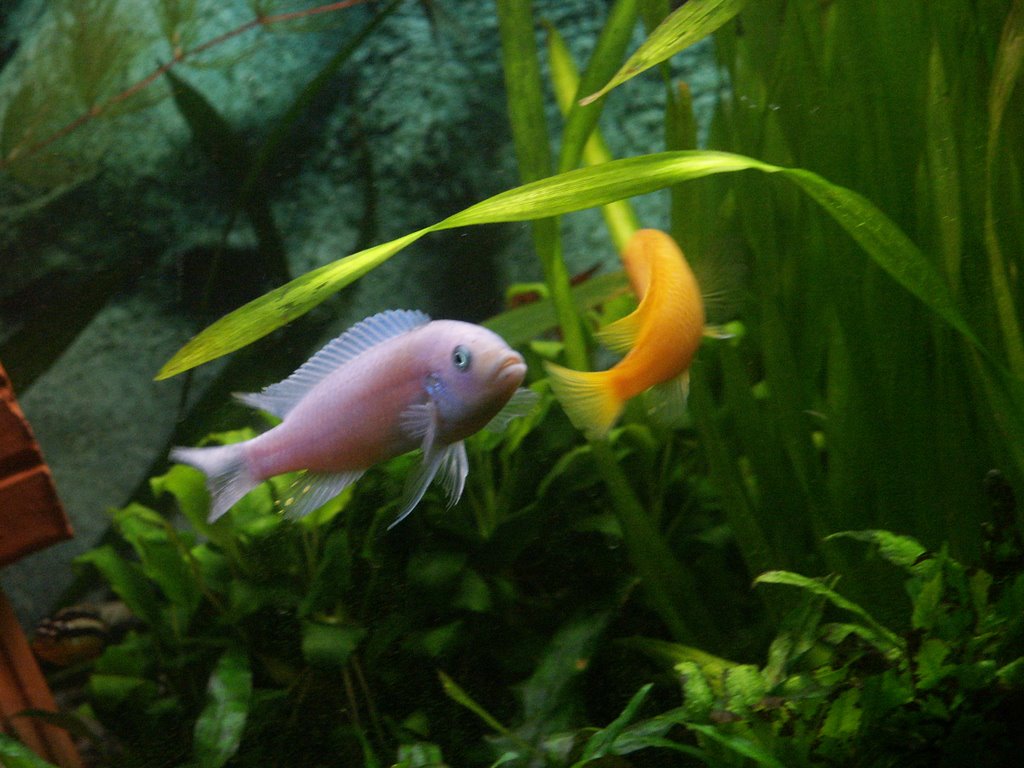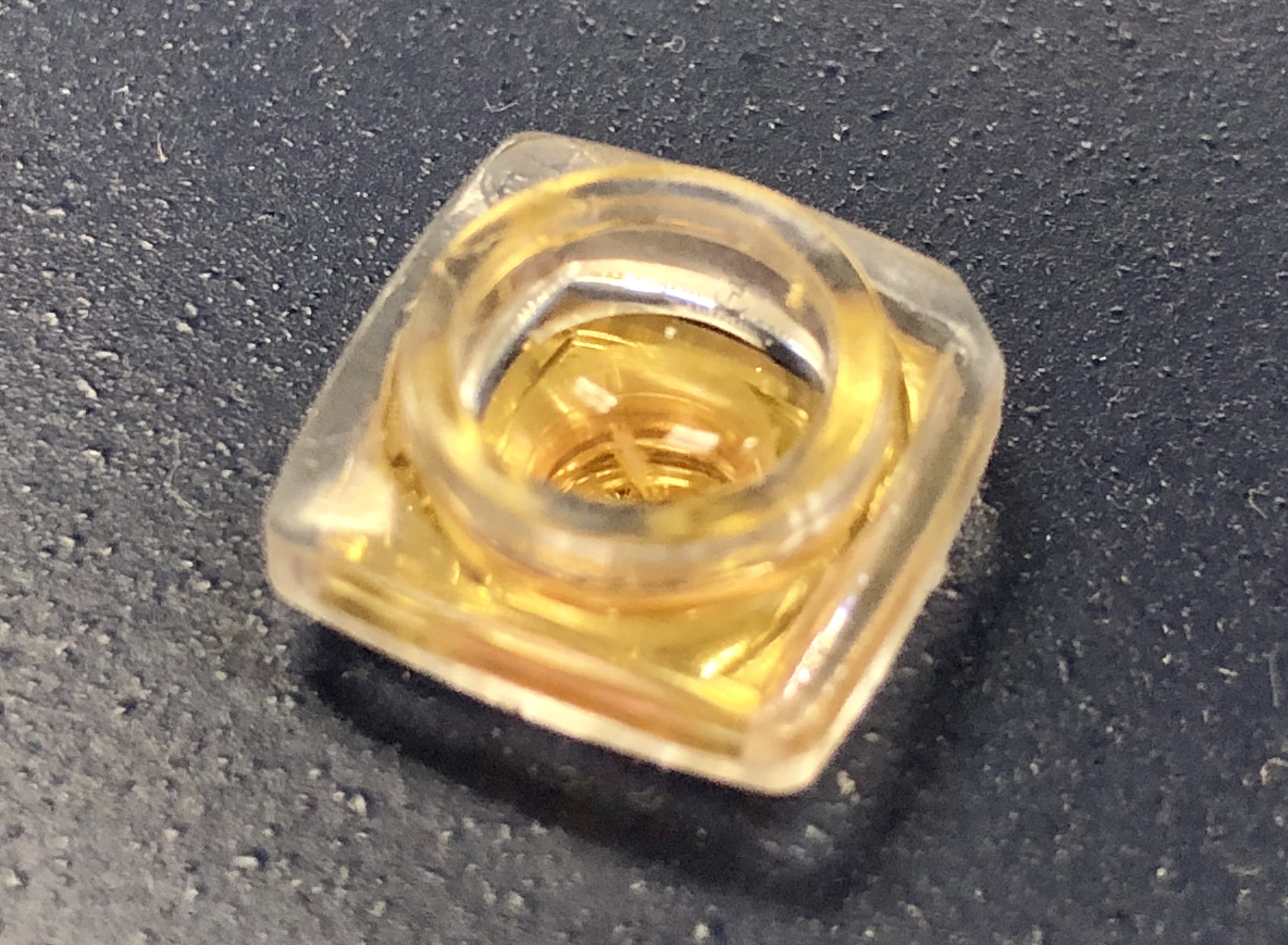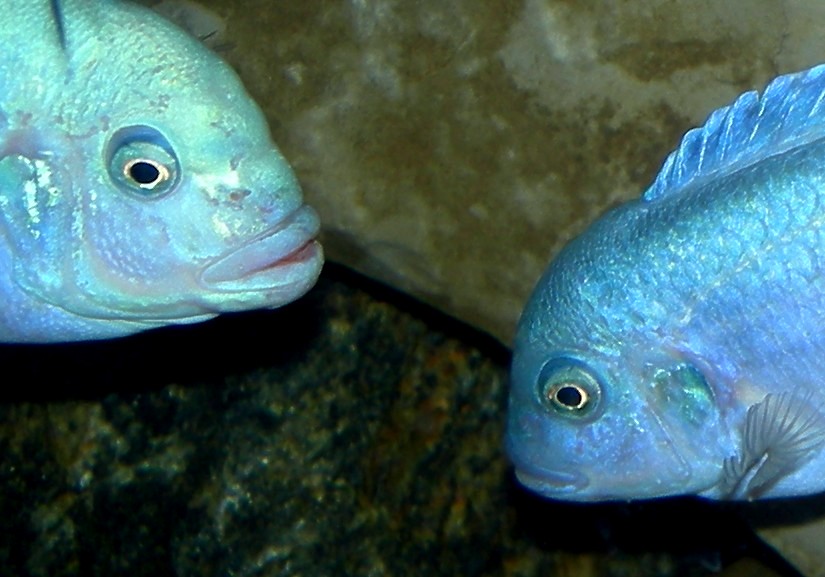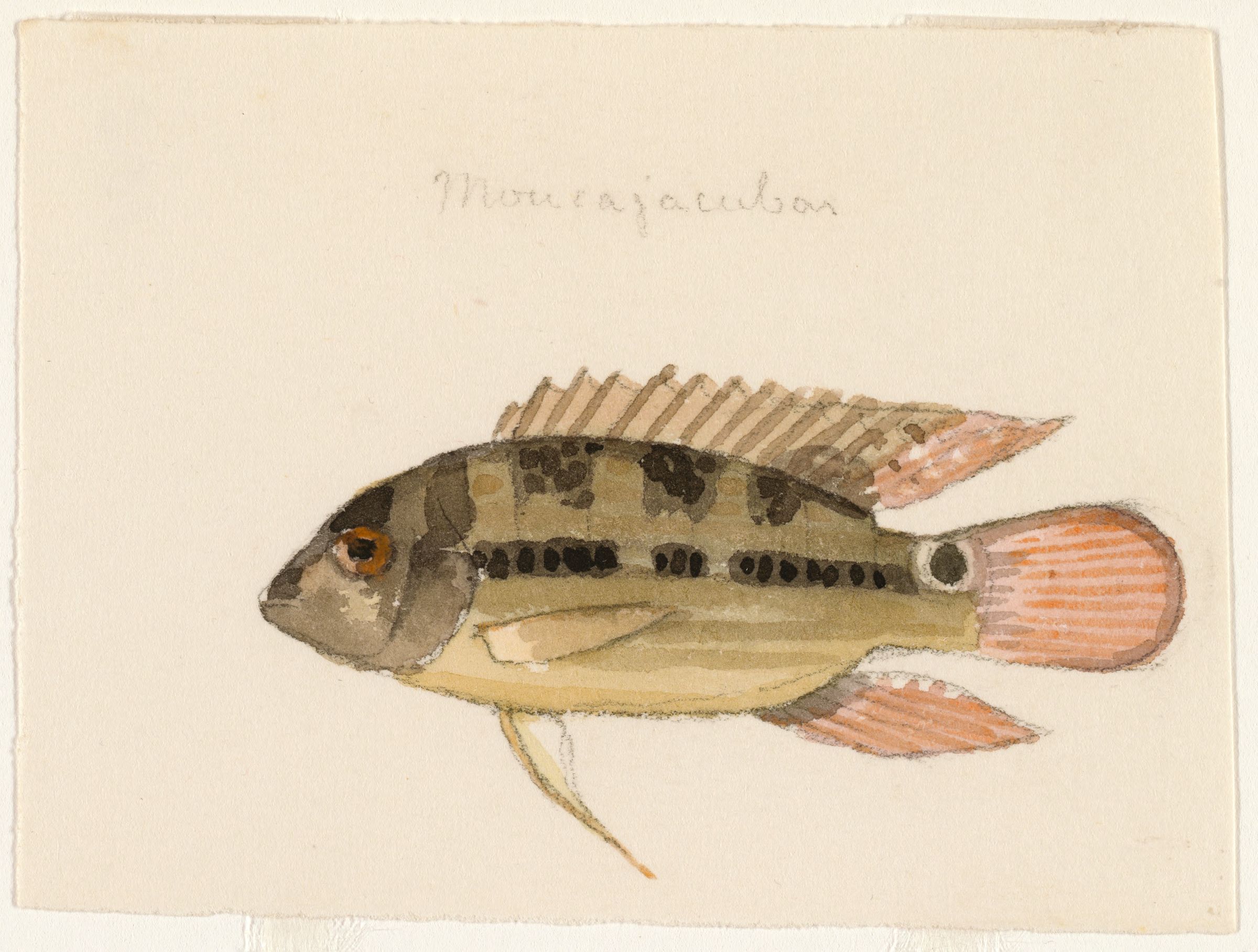|
Metriaclima Zebra
The zebra mbuna (''Maylandia zebra'') is a species of cichlid endemic to Lake Malawi in Africa. This species can reach a length of . It feeds on aufwuchs, a surface layer of mostly algal material that grows on rocks. This cichlid is a mouthbrooder and the female broods the eggs in her mouth for about three weeks. This fish can sometimes be found in the aquarium trade. Description The zebra mbuna has a single dorsal fin with sixteen to nineteen spines and seven to ten soft rays. The anal fin has three to four spines and six to nine soft rays. It grows to a maximum length of SL. The male fish varies in colour in different parts of its range, in some locations having a dark head, throat and belly and in others a blue head, whitish throat and grey/blue belly. In both cases the body is bright blue with up to eight grey/black bars, the dorsal fin is blue and the anal fin is blue to grey, with one to five orange to yellow spots. The female zebra mbuna is polymorphic, that is to say ... [...More Info...] [...Related Items...] OR: [Wikipedia] [Google] [Baidu] |
George Albert Boulenger
George Albert Boulenger (19 October 1858 – 23 November 1937) was a Belgian-British zoologist who described and gave scientific names to over 2,000 new animal species, chiefly fish, reptiles, and amphibians. Boulenger was also an active botanist during the last 30 years of his life, especially in the study of roses. Life Boulenger was born in Brussels, Belgium, the only son of Gustave Boulenger, a Belgian public notary, and Juliette Piérart, from Valenciennes. He graduated in 1876 from the Free University of Brussels (1834–1969), Free University of Brussels with a degree in natural sciences, and worked for a while at the Royal Belgian Institute of Natural Sciences, Brussels, as an assistant naturalist studying amphibians, reptiles, and fishes. He also made frequent visits during this time to the ''National Museum of Natural History (France), Muséum national d'Histoire naturelle'' in Paris and the Natural History Museum, London, British Museum in London. Boulenger develop ... [...More Info...] [...Related Items...] OR: [Wikipedia] [Google] [Baidu] |
Mouthbrooder
Mouthbrooding, also known as oral incubation and buccal incubation, is the care given by some groups of animals to their offspring by holding them in the mouth of the parent for extended periods of time. Although mouthbrooding is performed by a variety of different animals, such as the Darwin's frog, fish are by far the most diverse mouthbrooders. Mouthbrooding has evolved independently in several different families of fish. Mouthbrooding behaviour Paternal mouthbrooders are species where the male looks after the eggs. Paternal mouthbrooders include the arowana, various mouthbrooding bettas and gouramies such as '' Betta pugnax'', and sea catfish such as '' Ariopsis felis''. Among cichlids, paternal mouthbrooding is relatively rare, but is found among some of the tilapiines, most notably the black-chin tilapia '' Sarotherodon melanotheron''. In the case of the maternal mouthbrooders, the female takes the eggs. Maternal mouthbrooders are found among both African and South American ... [...More Info...] [...Related Items...] OR: [Wikipedia] [Google] [Baidu] |
Taxa Named By George Albert Boulenger
In biology, a taxon (back-formation from ''taxonomy''; : taxa) is a group of one or more populations of an organism or organisms seen by taxonomists to form a unit. Although neither is required, a taxon is usually known by a particular name and given a particular ranking, especially if and when it is accepted or becomes established. It is very common, however, for taxonomists to remain at odds over what belongs to a taxon and the criteria used for inclusion, especially in the context of rank-based (" Linnaean") nomenclature (much less so under phylogenetic nomenclature). If a taxon is given a formal scientific name, its use is then governed by one of the nomenclature codes specifying which scientific name is correct for a particular grouping. Initial attempts at classifying and ordering organisms (plants and animals) were presumably set forth in prehistoric times by hunter-gatherers, as suggested by the fairly sophisticated folk taxonomies. Much later, Aristotle, and later still ... [...More Info...] [...Related Items...] OR: [Wikipedia] [Google] [Baidu] |
Fish Described In 1899
A fish (: fish or fishes) is an aquatic, anamniotic, gill-bearing vertebrate animal with swimming fins and a hard skull, but lacking limbs with digits. Fish can be grouped into the more basal jawless fish and the more common jawed fish, the latter including all living cartilaginous and bony fish, as well as the extinct placoderms and acanthodians. In a break to the long tradition of grouping all fish into a single class (Pisces), modern phylogenetics views fish as a paraphyletic group. Most fish are cold-blooded, their body temperature varying with the surrounding water, though some large active swimmers like white shark and tuna can hold a higher core temperature. Many fish can communicate acoustically with each other, such as during courtship displays. The study of fish is known as ichthyology. The earliest fish appeared during the Cambrian as small filter feeders; they continued to evolve through the Paleozoic, diversifying into many forms. The earliest fish wi ... [...More Info...] [...Related Items...] OR: [Wikipedia] [Google] [Baidu] |
Maylandia
''Maylandia'' or ''Metriaclima'' is a genus of haplochromine cichlids endemism, endemic to Lake Malawi in East Africa. They belong to the mbuna (rock-dwelling) haplochromines. All species in this genus are relatively small fishes, less than in length. Like most Lake Malawi cichlids, exhibit brood care via maternal mouthbrooding. Numerous members of the genus are traded as aquarium fish. They are attractive because they are brightly colored and often very sexually dimorphic; like other cichlids they are not suited for beginners and for most companion tanks. Name The name ''Maylandia'', honours the cichlid enthusiast and author about aquaria Hans Joachim Mayland, who died in 2004, was proposed as a subgenus of ''Pseudotropheus'' in 1984, naming the long-known but undescribed "Ice Blue Zebra" as the type species. In 1997 Stauffer ''et al''. described the genus ''Metriaclima'', dismissing the pre-existing ''Maylandia'' on the assumption that it lacked a type species and a diagnosi ... [...More Info...] [...Related Items...] OR: [Wikipedia] [Google] [Baidu] |
Single-molecule Real-time Sequencing
Single-molecule real-time (SMRT) sequencing is a parallelized single molecule DNA sequencing method. Single-molecule real-time sequencing utilizes a zero-mode waveguide (ZMW). A single DNA polymerase enzyme is affixed at the bottom of a ZMW with a single molecule of DNA as a template. The ZMW is a structure that creates an illuminated observation volume that is small enough to observe only a single nucleotide of DNA being incorporated by DNA polymerase. Each of the four DNA bases is attached to one of four different fluorescent dyes. When a nucleotide is incorporated by the DNA polymerase, the fluorescent tag is cleaved off and diffuses out of the observation area of the ZMW where its fluorescence is no longer observable. A detector detects the fluorescent signal of the nucleotide incorporation, and the base call is made according to the corresponding fluorescence of the dye. Technology The DNA sequencing is done on a chip that contains many ZMWs. Inside each ZMW, a single active ... [...More Info...] [...Related Items...] OR: [Wikipedia] [Google] [Baidu] |
Pacific Biosciences
Pacific Biosciences of California, Inc. (aka PacBio) is an American biotechnology company founded in 2004 that develops and manufactures systems for gene sequencing and some novel real time biological observation. PacBio has two principal sequencing platforms: single-molecule real-time sequencing (SMRT), based on the properties of zero-mode waveguides and sequencing by binding (SBB) chemistry, which uses native nucleotides and scarless incorporation for DNA binding and extension. History The company was founded based on research done at Cornell University that combined semiconductor processing and photonics with biotechnology research. Three graduate students in the lab of Professors Watt W. Webb — Jonas Korlach — and Harold Craighead — Steve Turner and Mathieu Foquet — became the first employees. It began under the name Nanofluidics, Inc. The company raised nearly in six rounds of primarily venture capital financing, making it one of the most cap ... [...More Info...] [...Related Items...] OR: [Wikipedia] [Google] [Baidu] |
Nuclear DNA
Nuclear DNA (nDNA), or nuclear deoxyribonucleic acid, is the DNA contained within each cell nucleus of a eukaryotic organism. It encodes for the majority of the genome in eukaryotes, with mitochondrial DNA and plastid DNA coding for the rest. It adheres to Mendelian inheritance, with information coming from two parents, one male and one female—rather than matrilineally (through the mother) as in mitochondrial DNA. Structure Nuclear DNA is a nucleic acid, a polymeric biomolecule or biopolymer, found in the nucleus of eukaryotic cells. Its structure is a double helix, with two strands wound around each other, a structure first described by Francis Crick and James D. Watson (1953) using data collected by Rosalind Franklin. Each strand is a long polymer chain of repeating nucleotides. Each nucleotide is composed of a five-carbon sugar, a phosphate group, and an organic base. Nucleotides are distinguished by their bases: purines, large bases that include adenine and gu ... [...More Info...] [...Related Items...] OR: [Wikipedia] [Google] [Baidu] |
Maylandia Estherae Couple PICT8598
''Maylandia'' or ''Metriaclima'' is a genus of haplochromine cichlids endemic to Lake Malawi in East Africa. They belong to the mbuna (rock-dwelling) haplochromines. All species in this genus are relatively small fishes, less than in length. Like most Lake Malawi cichlids, exhibit brood care via maternal mouthbrooding. Numerous members of the genus are traded as aquarium fish. They are attractive because they are brightly colored and often very sexually dimorphic; like other cichlids they are not suited for beginners and for most companion tanks. Name The name ''Maylandia'', honours the cichlid enthusiast and author about aquaria Hans Joachim Mayland, who died in 2004, was proposed as a subgenus of '' Pseudotropheus'' in 1984, naming the long-known but undescribed " Ice Blue Zebra" as the type species. In 1997 Stauffer ''et al''. described the genus ''Metriaclima'', dismissing the pre-existing ''Maylandia'' on the assumption that it lacked a type species and a diagnosis. Two y ... [...More Info...] [...Related Items...] OR: [Wikipedia] [Google] [Baidu] |
Juvenile Fish
Fish go through various life stages between fertilization and adulthood. The life of fish start as spawned eggs which hatch into immotile larvae. These larval hatchlings are not yet capable of feeding themselves and carry a yolk sac which provides stored nutrition. Before the yolk sac completely disappears, the young fish must mature enough to be able to forage independently. When they have developed to the point where they are capable of feeding by themselves, the fish are called fry. When, in addition, they have developed scales and working fins, the transition to a juvenile fish is complete and it is called a fingerling, so called as they are typically about the size of human fingers. The juvenile stage lasts until the fish is fully grown, sexually mature and interacting with other adult fish. Growth stages Ichthyoplankton ''(planktonic or drifting fish)'' are the eggs and larvae of fish. They are usually found in the sunlit zone of the water column, less than 200 m ... [...More Info...] [...Related Items...] OR: [Wikipedia] [Google] [Baidu] |
Invertebrate
Invertebrates are animals that neither develop nor retain a vertebral column (commonly known as a ''spine'' or ''backbone''), which evolved from the notochord. It is a paraphyletic grouping including all animals excluding the chordata, chordate subphylum Vertebrata, i.e. vertebrates. Well-known Phylum, phyla of invertebrates include arthropods, molluscs, annelids, echinoderms, flatworms, cnidarians, and sponges. The majority of animal species are invertebrates; one estimate puts the figure at 97%. Many invertebrate taxon, taxa have a greater number and diversity of species than the entire subphylum of Vertebrata. Invertebrates vary widely in size, from 10 Micrometre, μm (0.0004 in) myxozoans to the 9–10 m (30–33 ft) colossal squid. Some so-called invertebrates, such as the Tunicata and Cephalochordata, are actually sister chordate subphyla to Vertebrata, being more closely related to vertebrates than to other invertebrates. This makes the "invertebrates" para ... [...More Info...] [...Related Items...] OR: [Wikipedia] [Google] [Baidu] |
Cichlid
Cichlids () are a large, diverse, and widespread family of percomorph fish in the family Cichlidae, order Cichliformes. At least 1,760 species have been scientifically described, making it one of the largest vertebrate families, with only the Cyprinidae being more speciose. New species are discovered annually, and many species remain undescribed. The actual number of species is therefore unknown, with estimates varying between 2,000 and 3,000. They are native to the Neotropics, Africa (including Madagascar), the Middle East, and the Indian subcontinent, although some species have been introduced worldwide. Many cichlids, particularly tilapia, are important food fishes, while others, such as the '' Cichla'' species, are valued game fish. The family also includes many popular freshwater aquarium fish kept by hobbyists, including the angelfish, oscars, and discus. Cichlids have the largest number of endangered species among vertebrate families, most in the haplochrom ... [...More Info...] [...Related Items...] OR: [Wikipedia] [Google] [Baidu] |










